So I've been cooking Indian food for pretty much as long as I've known Martin, and I had a few vegetarian Indian dishes in my rotation even before that. (Yes, I was once a vegetarian. Shocking, I know.) So this week I'm on familiar ground, even though I'll admit that my curry-making experience hasn't thus far included fish, which is what I decided to tackle for my dinnertime trip to Bengal, India. ("Tackle," haw haw.)
 |
| Bengali fish curry with dhania aloo. |
Now as you probably can guess, Bengal India is not a country; it's an eastern Indian state that shares a language and much of its culinary tradition with neighboring Bangladesh, which we actually covered a few weeks ago. Bengal has one of the largest economies in India but is also one of the most densely populated regions on Earth, with a poverty rate that hovers at a whopping 30%.
 |
| Bengal and its eastern neighbor, Bangladesh. |
Bengal is home to the world's largest mangrove forest, and its southern border lies along the coastline of the world's largest bay, the Bay of Bengal. Most of the land in the state of Bengal is within 33 feet of sea level, so it's not surprising that fish based dishes are among the traditional favorites. Rice and potatoes are important staples, which along with maize, tea, jute and pulses are grown in the area and account for a significant portion of the Bengal economy.
So with this in mind I decided I was going to make a fish curry. Now I'll say up front that my fish curry wasn't 100% authentic, mainly because the fish species they eat in that part of the world just aren't the same as the ones you can find over here. Because of the way this dish is prepared, you need a pretty firm-fleshed fish, so I chose cod. You could probably also do this with something like swordfish or mahi-mahi.
Here's the recipe, which came from a website called Indobase.com:
Bengali Fish Curry
For the spice mix:
- 2 tsp coriander seeds
- 1 tsp cumin seeds
- 2 dried hot red chiles
- 2 whole cloves
- 2 green cardamom pods
- 1-inch cinnamon stick
For the fish:
- 2 lbs firm white fish, cut into bite-sized pieces (I used cod)
- 3/4 tsp ground turmeric
- 1/2 tsp salt
- 2 tbsp canola oil
For the sauce:
- 3/4 cup onion, finely chopped
- 1 tsp fresh ginger, grated and peeled
- 1 garlic clove, minced
- 1 Indian bay leaf
- 1/4 cup water
- 1 tsp salt
- 1/2 tsp sugar
- 1 cup plain whole milk yogurt
On the side I decided to go with a potato dish instead of the usual dal or rice-based side. This recipe also comes from Indobase and is called Dhania Aloo:
- 10 small potatoes, peeled and parboiled for five minutes
- Oil for frying
- 3 1/2 oz cilantro leaves, made into a paste
- 1 Indian bay leaf
- 2 red chillies
- 3 onions, sliced
- 4 garlic cloves, crushed
- 1/2 tsp coriander powder
- 1/2 tsp turmeric powder
- Salt to taste
And for dessert I decided to brave a rice pudding, called Khejur Gur er Paayesh in Bengal. This recipe comes from "Bong Mom" who blogs at bongcookbook.com.
- 5 1/2 cups whole milk
- 1 3/4 cup half and half
- 2/3 cup basmati rice
- 1/2 tsp ghee, melted
- A handful of golden raisins, soaked in water
- 3 or 4 Indian bay leaves
- 1 cup sugar
- 3/4 cup jaggery
Ingredient note: Jaggery is a traditional unrefined cane sugar. It is not too difficult to find; you should be able to get it in an Indian market, or you can do like me and order it from Amazon.com. Mine arrived in lumps which I had to break apart before using.
The first thing I did was make the rice pudding, which can be served either hot or cold--I voted for cold since that's the way it usually comes in a restaurant but also because that meant I could make it ahead of time and not have to stress about having it ready at the exact right moment.
So let me start off by warning you, rice pudding is really time consuming. You can't leave the pot and walk away to do something else, because milk scalds easily and rice pudding is made from thickened milk.
Here's how it's done:
First wash the rice. I put my rice in a fine mesh strainer and just let the tap run over it while I put the raisins in water to soak and got the milk ready.
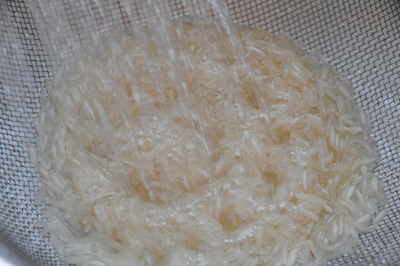 |
| Wash the rice in a fine mesh strainer. |
When the rice has been rinsed, drain it well and put it in a bowl. Add the melted ghee and stir to coat.
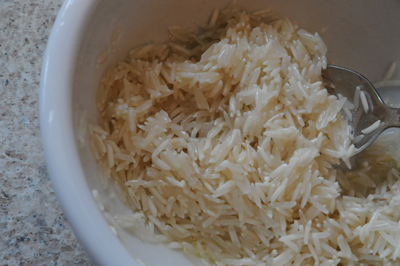 |
| Basmati rice after adding a little ghee. |
Combine the milk and half and half in a large heavy bottomed pot and add the bay leaves. Bring just to a boil, then add the rice.
Now stir. Stir some more. Stir some more. Did you bring a book? Your iPad? If not you will be bored.
After about 10 minutes check the rice. It needs to be done before you add the sugar, warns Bong Mom, else the sugar will prevent it from cooking all the way.
When the rice is cooked through, add the sugar and keep stirring. Remember to stretch your back and shift your weight from the right foot to the left, but don't stop stirring because your milk will scald. Keep this up until the milk thickens; you will know it's ready when you use your right hand to pour a little bit into the center of a plate, while continuing to stir with your left hand, or vice versa. If the milk doesn't flow and stays pretty much in a button shape in the middle of the plate, it's ready. Finally. Take the pot off the heat.
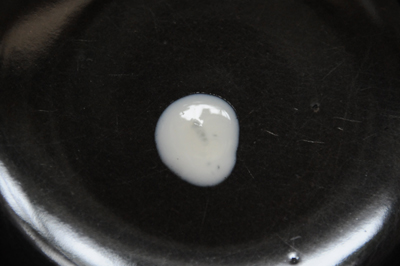 |
| This is that button shape you're going for. It took me 40 minutes to get there. |
It took about 40 minutes for my milk to thicken, but Bong Mom says it can take up to an hour.
Let the pudding sit for five minutes, then add the jaggery (if your jaggery is like mine was, you'll need to crush it so it will melt into the pudding). Then add the raisins. If serving cold, cover and place in the refrigerator until ready to eat.
 |
| Stir in the jaggery and let melt. |
Now on to the potatoes. The recipe called for "small potatoes, boiled and peeled" which required a little interpretation. I used new potatoes, which you wouldn't usually peel, but I peeled them anyway. Then I quartered them and parboiled them for five minutes so they were still pretty firm. I didn't think boiling them fully was a good idea since they needed to be fried in the next step, and boiled potatoes quickly turn into mashed potatoes in a frying pan.
While the potatoes are boiling, make a paste out of the cilantro. To do this, I just put the leaves in my mini food processor and added a little water, then pulsed until I had a paste.
So yes, next you drain the potatoes and put them in a pan with hot canola oil. Fry them until they are golden, then remove them with a slotted spoon and set aside.
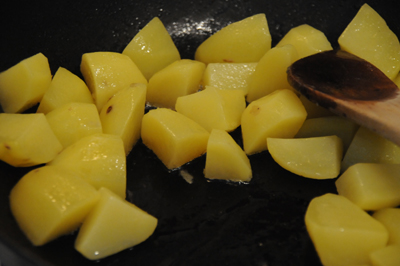 |
| Before ... |
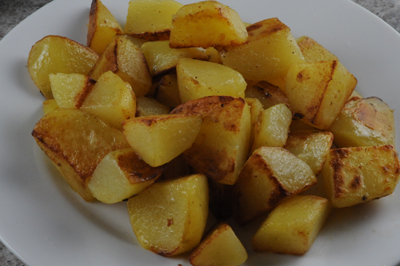 |
| After! |
Add a little more oil to the pan, and put in the red chilies and the bay leaf. Another interpretation: the recipe didn't say anything about dicing the chilies, so I assumed whole dried chilies. You could use fresh ones too, I suppose, since the recipe doesn't really say which version it wants.
Saute the chilies and bay leaf in the oil for a few minutes, then add the sliced onions and crushed garlic.
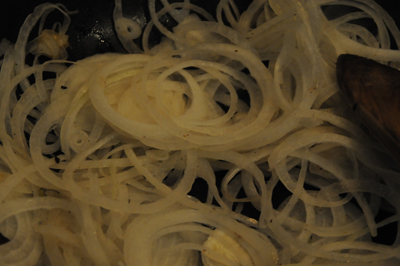 |
| Here's that compulsory frying onions picture. |
Top that off with the spices and saute for one or two minutes more.
Finally, add the potatoes and cilantro paste and stir. Cover the pan and cook on low heat, stirring occasionally, until the potatoes are cooked through.
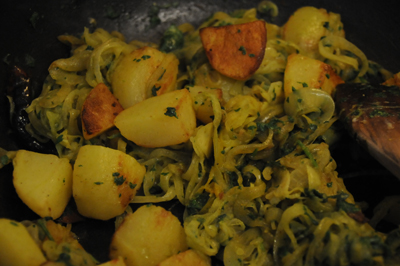 |
| These are nearly finished. |
While you're working on the potatoes you can multi-task your way through the fish curry, which takes a little bit less time since fish cooks so much faster than potatoes.
Put the spice mix ingredients in a grinder or mortar and pestle and crush to a fine powder. Set aside.
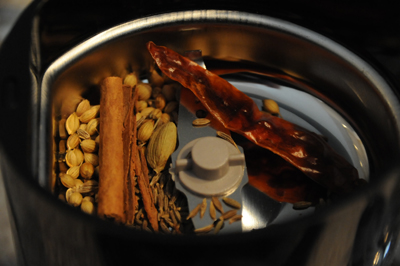 |
| Coffee grinders have oh-so many uses. |
Now cut your fish up into chunks and place in a large bowl with the salt and turmeric powder. Toss until all your fish pieces are a nice yellow color.
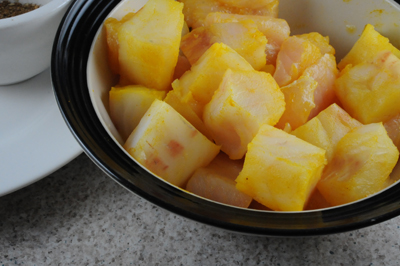 |
| The beauty of turmeric. |
Heat the canola oil and fry the fish until it is lightly browned. Remove with a slotted spoon and set aside.
Add a little more oil to the pan (if needed), then add the chopped onions. Saute until translucent.
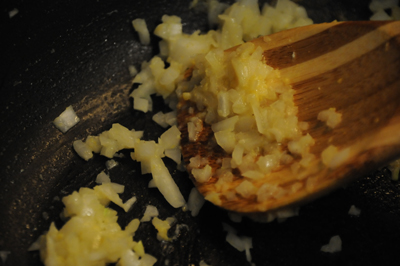 |
| This is a pretty dry curry until you add the yogurt, so keep stirring. |
Add the ginger, garlic and bay leaf and cook for one or two minutes. Then add the spice mix and cook for another couple of minutes.
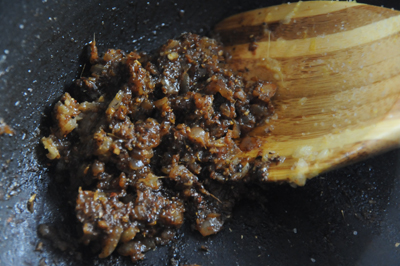 |
| After adding the spices you'll get this lovely brown paste. |
Pour in the water along with the salt and sugar. Then take the pan off the heat and add the yogurt, stirring until all the ingredients are well-incorporated. Put the pot back on the stove over low heat and cook for five minutes, stirring occasionally to prevent burning.
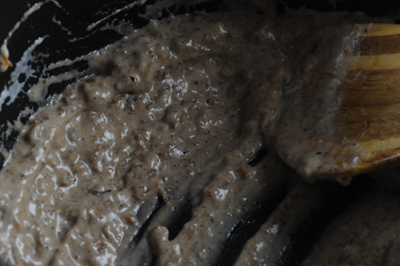 |
| Now add the yogurt. This sauce was not the same color as the one on Indobase.com. |
Return the fish and any juices to the pot and continue to cook over low heat, for five minutes or until the fish is cooked through. Now take out the bay leaf and serve (I poured mine over basmati rice, even though I already had another starch on the table. Evidently it's not that strange to eat rice with potatoes in Bengal).
As you may have guessed, this was one of those meals that I let my kids skip, mainly because of the fish but also because of the myriad of kid-scary things I added to it, namely green paste and large pieces of onion. So Martin and I dined alone.
I have to confess that Martin seemed totally indifferent about the curry, so I'm not actually sure whether I broke a marriage vow. He does tend to be indifferent about fish in general, so I guess I'm not too offended. I liked the fish; it was definitely a different way to enjoy the Indian spices I've always been so fond of.
Martin did praise the potatoes and especially the accompanying onions, which were slightly sweet and very flavorful. But he especially liked the rice pudding, which is not surprising since he usually orders rice pudding for dessert whenever we go out for a curry.
Personally, I dislike rice pudding, which makes my choice of dessert for this week a little strange. But I have to say, I really did like this one. I can't put my finger on what was different about it; it was incredibly rich and sweet and tasted wonderful with the raisins. Sadly, though, I'll never make it again. Way too much stirring.
Next week: Benin.
For printable versions of this week's recipes:











0 comments:
Post a Comment